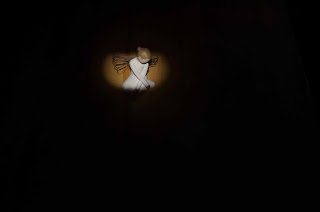For this final exercise of the assignment I chose to photograph a spoon that had reflective properties.
This is the spoon taken from above with no filtering of the light. I am reflected in the spoon along with the camera.
I then used a cone of the baking/tracing paper around the lens to try to filter out some of the reflections.
Here are the results:
After varying degrees of success starting with the first shot where the cone was not close enough to the spoon I managed to remove quite a lot of the reflections but never quite managed to get rid of them all.
Friday, April 26, 2013
Exercise 12. Concentrating light
For this exercise I used a similar object that I had used for exercise 10. I then set my camera to use the flash and made a cardboard tube that fitted around the camera built in flash. I then took various shots from different distances and with varying lengths of tube.
These are some of the results:
These are some of the results:
 |
| Narrow from close up |
 |
| Narrow from distance |
 |
| Narrow tube |
 |
| Wide tube |
Exercise 11. Contrast and shadow fill
 |
| no diffuser |
 |
| diffuser |
 |
| white card meter away |
 |
| white card half distance |
 |
| White card very near |
 |
| Aluminium foil dull side 1 m away |
 |
| Aluminium foil dull side 0.5 m away |
 |
| Aluminium foil shiny side 1 m away |
 |
| Aluminium foil dull side 0.5 m away |
It is clear that the shot with undiffused lamp and no reflector has the most contrast. The inside of the box is darker and the shadows more pronounced.
The various types of reflectors have different degrees of effectiveness in reflecting the light and exposing the box.
Exercise 10. The lighting angle
These are the shots:
 |
| Diffuser front and level |
 |
| right and level |
 |
| rear and level |
 |
| level right |
45 degrees front
 |
| Add caption |
 |
| 45 degrees right |
 |
| 45 degrees back |
 |
| 45 degrees left |
 |
| Directly above |
 |
| Above and behind |
 |
| Above and in front |
I think that my favourite is the one lit from directly above. It has a little silhouetting and also good definition and contrast.
Exercise 9. Softening the light
For this exercise I choose a still life of a some eggs in their stand. I set the camera up on a tripod looking slightly down on the eggs. I used a lamp held directly above the eggs for the shots. The first shot was with a naked light the second was diffused with some baking paper.
In the first shot the most noticeable aspect is that the eggs are more clearly defined and that the contours are more visible. There are strong shadows both around the eggs and the holder. The shadows in the first shot are much darker and stronger and have more definition. The second shot is much softer generally, the edges of the shadows in particular have less definition and blend into the background. The difference in the contrast between the two shots is also clear the, in the first shot there is clearly a greater contrast between the darks and lights.
In this shot it is not clear to me whether the diffusion is an improvement as it depends on what you are trying to capture. If it is a shot with plenty of detail then the naked shot is better, for a shot that is maybe more pleasing on the eye the second shot with the soft contrast is probably better.
 |
| Naked light |
 |
| Diffused light |
In this shot it is not clear to me whether the diffusion is an improvement as it depends on what you are trying to capture. If it is a shot with plenty of detail then the naked shot is better, for a shot that is maybe more pleasing on the eye the second shot with the soft contrast is probably better.
Exercise 8. Outdoors at night
For this shoot I used my local city , Lincoln. Lincoln has a lot of interesting buildings and like most cities is well lit at night. I tried to take a variety of shots in different conditions. For many of the photos I used a tripod and a wide aperture with my prime lens.
Subscribe to:
Comments (Atom)























